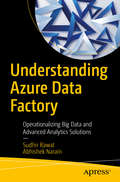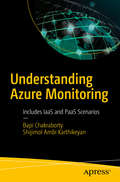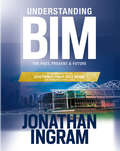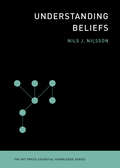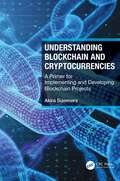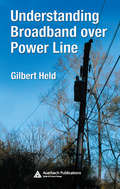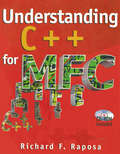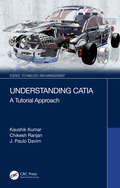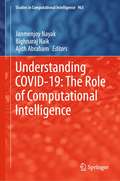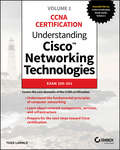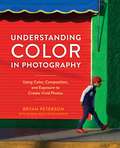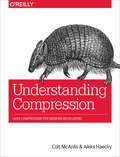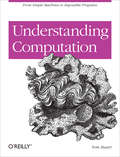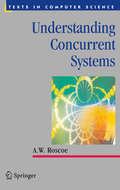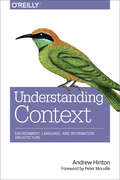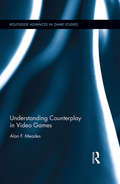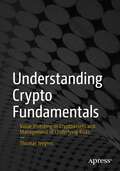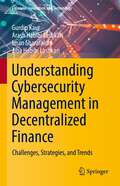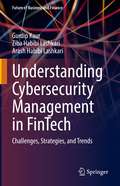- Table View
- List View
Understanding Azure Data Factory: Operationalizing Big Data And Advanced Analytics Solutions
by Sudhir Rawat Abhishek NarainImprove your analytics and data platform to solve major challenges, including operationalizing big data and advanced analytics workloads on Azure. You will learn how to monitor complex pipelines, set alerts, and extend your organization's custom monitoring requirements.This book starts with an overview of the Azure Data Factory as a hybrid ETL/ELT orchestration service on Azure. The book then dives into data movement and the connectivity capability of Azure Data Factory. You will learn about the support for hybrid data integration from disparate sources such as on-premise, cloud, or from SaaS applications. Detailed guidance is provided on how to transform data and on control flow. Demonstration of operationalizing the pipelines and ETL with SSIS is included. You will know how to leverage Azure Data Factory to run existing SSIS packages. As you advance through the book, you will wrap up by learning how to create a single pane for end-to-end monitoring, which is a key skill in building advanced analytics and big data pipelines. What You'll LearnUnderstand data integration on Azure cloudBuild and operationalize an ADF pipelineModernize a data warehouseBe aware of performance and security considerations while moving data Who This Book Is ForData engineers and big data developers. ETL (extract, transform, load) developers also will find the book useful in demonstrating various operations.
Understanding Azure Monitoring: Includes IaaS and PaaS Scenarios
by Bapi Chakraborty Shijimol Ambi KarthikeyanExplore the architectural constructs of Azure monitoring capabilities and learn various design and implementation aspects for complex use cases. This book covers the different scenarios in a modern-day multi-cloud enterprise and the tools available in Azure for monitoring and securing these environments. Understanding Azure Monitoring starts by discussing the rapid changes happening in the cloud and the challenges faced by cloud architects. You will then look at the basics of Azure monitoring and the available tools, including service level agreements (SLAs), auditing, and security. Next, you will learn how to select the best tools for monitoring, operational strategy, and integration with on-premises SIEM systems. You’ll work through some scenario-based examples to monitor the workload and respond to failures. Here, you will monitor a simple web application on Azure, a multi-region web application, and applications that include PaaS and IaaS services. Towards the end of the book, you will explore monitoring in DevOps and see why it is important to be aware of continuous changes. What You Will LearnWork with Azure IaaS and PaaS resources and monitoring and diagnostics capabilitiesDiscover how the operational landscape changes on AzureLook at cloud-only and on-premises hybrid integrationStudy architectural constructs for design and implementationWho This Book Is ForInfrastructure and solution architects who want to integrate Azure-based monitoring solutions in a cloud native or hybrid-cloud architecture.
Understanding BIM: The Past, Present and Future
by Jonathan IngramUnderstanding BIM presents the story of Building Information Modelling, an ever evolving and disruptive technology that has transformed the methodologies of the global construction industry. Written by the 2016 Prince Philip Gold Medal winner, Jonathan Ingram, it provides an in-depth understanding of BIM technologies, the business and organizational issues associated with its implementation, and the profound advantages its effective use can provide to a project team. Ingram, who pioneered the system heralding the BIM revolution, provides unrivalled access to case material and relevance to the current generation of BIM masters. With hundreds of colour images and illustrations showing the breadth and power of BIM, the book covers: The history of BIM What BIM is in technical and practical terms How it changes the day to day working environment Why we need BIM and what problems it can solve Where BIM is headed, particularly with regards to AI, AR, VR and voice recognition International case studies from a range of disciplines including: architecture, construction management, and retail Professionals and students in any field where the inter-disciplinary aspects of BIM are in operation will benefit from Ingram’s insights. This book is an authoritative account of and reference on BIM for anyone wanting to understand its history, theory, application and potential future developments.
Understanding Beliefs (The MIT Press Essential Knowledge Series)
by Nils J. NilssonWhat beliefs are, what they do for us, how we come to hold them, and how to evaluate them. Our beliefs constitute a large part of our knowledge of the world. We have beliefs about objects, about culture, about the past, and about the future. We have beliefs about other people, and we believe that they have beliefs as well. We use beliefs to predict, to explain, to create, to console, to entertain. Some of our beliefs we call theories, and we are extraordinarily creative at constructing them. Theories of quantum mechanics, evolution, and relativity are examples. But so are theories about astrology, alien abduction, guardian angels, and reincarnation. All are products (with varying degrees of credibility) of fertile minds trying to find explanations for observed phenomena. In this book, Nils Nilsson examines beliefs: what they do for us, how we come to hold them, and how to evaluate them. We should evaluate our beliefs carefully, Nilsson points out, because they influence so many of our actions and decisions.Some of our beliefs are more strongly held than others, but all should be considered tentative and changeable. Nilsson shows that beliefs can be quantified by probability, and he describes networks of beliefs in which the probabilities of some beliefs affect the probabilities of others. He argues that we can evaluate our beliefs by adapting some of the practices of the scientific method and by consulting expert opinion. And he warns us about “belief traps”—holding onto beliefs that wouldn't survive critical evaluation. The best way to escape belief traps, he writes, is to expose our beliefs to the reasoned criticism of others.
Understanding Blockchain and Cryptocurrencies: A Primer for Implementing and Developing Blockchain Projects
by Akira SummersWhether you are a project manager looking to lead blockchain projects, a developer who would like to create blockchain-based applications, or a student with an interest, this book will provide you with the foundational understanding that you need.You have probably noticed that blockchains are growing in popularity. Governments are investigating Digital Currencies, supply chains are adopting Digital Ledgers, games makers and artists are developing NFTs (Non-Fungible Tokens), and new use-cases are emerging regularly.With such growth, many people will find themselves needing to understand how these technologies work. There will be new project teams, with technical leads managing blockchain projects and developers creating distributed applications. This book is great for them as it explains the concepts on which blockchain technologies are based, in simple terms.We will discuss and explain topics such as hashing, Merkle trees, nodes, mining, proof of work and proof of stake, consensus mechanisms encryption, vulnerabilities, and much more. The structures and principles described will be relevant for developers and managers alike, and will be demonstrated through relevant examples throughout the text.If you are looking to understand this exciting new technology, this is the book for you.
Understanding Broadband over Power Line
by Gilbert HeldUnderstanding Broadband over Power Line explores all aspects of the emerging technology that enables electric utilities to provide support for high-speed data communications via their power infrastructure. This book examines the two methods used to connect consumers and businesses to the Internet through the utility infrastructure: the existing ele
Understanding C++ for MFC
by Richard RaposaJumpstart your MFC programming without the tedious study of C++! Now you can learn C++ and MFC together -- learning C++ principles on a need-to-know basis. Author Richard Raposa has refined this tutorial over years of teaching Windows programming in quick
Understanding CATIA: A Tutorial Approach (Science, Technology, and Management)
by J. Paulo Davim Kaushik Kumar Chikesh RanjanThis book provides a key understanding of CATIA which is a solid modeling software. By using screen shots of step-by-step training, the reader will obtain comprehensive knowledge of all tools provided in CATIA for use in a variety of engineering fields. The book introduces CATIA basics, covers part design, discusses sheet metal design, talks about assembly, presents drawings and shows modeling of an engineered component. The primary aim of this book is to assist in learning the use of CATIA software through examples taken from various areas of engineering. The content and treatment of the subject matter is most appropriate for university students studying engineering and practicing engineers who wish to learn the use of CATIA.
Understanding COVID-19: The Role of Computational Intelligence (Studies in Computational Intelligence #963)
by Ajith Abraham Janmenjoy Nayak Bighnaraj NaikThis book provides a comprehensive description of the novel coronavirus infection, spread analysis, and related challenges for the effective combat and treatment. With a detailed discussion on the nature of transmission of COVID-19, few other important aspects such as disease symptoms, clinical application of radiomics, image analysis, antibody treatments, risk analysis, drug discovery, emotion and sentiment analysis, virus infection, and fatality prediction are highlighted. The main focus is laid on different issues and futuristic challenges of computational intelligence techniques in solving and identifying the solutions for COVID-19. The book drops radiance on the reasons for the growing profusion and complexity of data in this sector. Further, the book helps to focus on further research challenges and directions of COVID-19 for the practitioners as well as researchers.
Understanding Cisco Networking Technologies: Volume 1 Exam 200-301
by Todd LammleCovers the core elements of the CCNA certification: Understand the fundamental principles of computer networking Learn about network components, services, and infrastructure Prepare for the next steps toward Cisco certification Read BEFORE the CCNA Certification Study Guide, Volume 2 — Covers core CiscoTM network technologies Understanding Cisco Networking Technologies, Volume 1, is your first step on the path to preparing for Cisco's EXAM 200-301: Implementing and Administering Cisco Networking Technologies certification and the world of Internetworking. Cisco certification is a perfect way to enter the IT sector or advance your current IT career. Cisco Certified Network Associate (CCNA) is the associate-level certification that validates your ability to implement and administer a wide range of IT networking technologies. This book covers everything you need to know for preparing for both your CCNA studies and the future of your career. You will gain a solid foundational knowledge of networking and develop real-world network management skills. Clear, easy-to-follow chapters cover topics such as the basics of the Open Systems Interconnection (OSI) model, ethernet networking, TCP/IP, the Cisco Internetworking Operating System (IOS) and command-line interface (CLI), router configuration and management, and much more. Throughout the text, practice examples reinforce key information and what you need to know for the CCNA exam. In-depth yet highly readable, Understanding Cisco Networking Technologies is a must-have for anyone thinking of entering the IT profession, preparing for the CCNA certification, or wanting to develop a strong understanding of core Cisco networking technologies. Learn about: Open systems interconnection Ethernet networking and data encapsulation Internet Protocol and IP addressing Subnetting a network Troubleshooting IP issues Managing a Cisco internetwork Configuring network devices IP addressing and static, default and dynamic routing Wide Area Network (WAN) protocols ABOUT THE CISCO CCNA PROGRAM The Cisco Certified Network Associate (CCNA) program prepares candidates for associate-level job roles in IT technologies. The CCNA exam tests a candidate's knowledge and skills related to network fundamentals, network access, IP connectivity, IP services, security fundamentals, and automation and programmability. Visit www.cisco.com/c/en/us/training- events.html for more information.
Understanding Color in Photography: Using Color, Composition, and Exposure to Create Vivid Photos
by Bryan Peterson Susana Heide SchellenbergVeteran photographer and instructor Bryan Peterson is best known for his arresting imagery using bold, graphic color and composition. Here he explores his signature use of color in photography for the first time, showing readers his process for creating striking images that pop off the page. He addresses how to shoot in any type of light, and looks at color families and how they can work together to make compelling images in commercial and art photography. He also helps readers understand exposure, flash, and other stumbling blocks that beginning and experienced photographers encounter when capturing images, showing how to get the most out of any composition. With its down-to-earth voice and casual teaching style, Understanding Color in Photography is a workshop in a book, helping any photographer take their images to the next level.
Understanding Compression: Data Compression for Modern Developers
by Aleks Haecky Colt McAnlisIf you want to attract and retain users in the booming mobile services market, you need a quick-loading app that won’t churn through their data plans. The key is to compress multimedia and other data into smaller files, but finding the right method is tricky. This witty book helps you understand how data compression algorithms work—in theory and practice—so you can choose the best solution among all the available compression tools.With tables, diagrams, games, and as little math as possible, authors Colt McAnlis and Aleks Haecky neatly explain the fundamentals. Learn how compressed files are better, cheaper, and faster to distribute and consume, and how they’ll give you a competitive edge.Learn why compression has become crucial as data production continues to skyrocketKnow your data, circumstances, and algorithm options when choosing compression toolsExplore variable-length codes, statistical compression, arithmetic numerical coding, dictionary encodings, and context modelingExamine tradeoffs between file size and quality when choosing image compressorsLearn ways to compress client- and server-generated data objectsMeet the inventors and visionaries who created data compression algorithms
Understanding Computation: From Simple Machines to Impossible Programs
by Tom StuartFinally, you can learn computation theory and programming language design in an engaging, practical way. Understanding Computation explains theoretical computer science in a context you’ll recognize, helping you appreciate why these ideas matter and how they can inform your day-to-day programming.Rather than use mathematical notation or an unfamiliar academic programming language like Haskell or Lisp, this book uses Ruby in a reductionist manner to present formal semantics, automata theory, and functional programming with the lambda calculus. It’s ideal for programmers versed in modern languages, with little or no formal training in computer science.Understand fundamental computing concepts, such as Turing completeness in languagesDiscover how programs use dynamic semantics to communicate ideas to machinesExplore what a computer can do when reduced to its bare essentialsLearn how universal Turing machines led to today’s general-purpose computersPerform complex calculations, using simple languages and cellular automataDetermine which programming language features are essential for computationExamine how halting and self-referencing make some computing problems unsolvableAnalyze programs by using abstract interpretation and type systems
Understanding Computer Organization: A Guide to Principles Across RISC-V, ARM Cortex, and Intel Architectures (Undergraduate Topics in Computer Science)
by Patricio BulićThis textbook unlocks modern computer organizations' secrets, with real-world examples from RISC-V, ARM, and Intel-based computer systems. The guide provides a comprehensive yet accessible explanation of fundamental principles and components and serves as a gateway to mastering the interplay between hardware and software. It demystifies complex concepts and provides clear explanations and practical insights into their roles in computing systems. Topics and features: Provides comprehensive coverage of computer organization principles across three major architectures (RISC-V, ARM Cortex, and Intel), ensuring a broad understanding of modern computing Includes numerous practical explanations using real-world examples from each architecture, offering hands-on insights into memory-mapped I/O, interrupts, DMA, and various memory technologies Presents detailed exploration of diverse components such as interrupts and their usage, interrupt controllers, DMA transfers, and DMA controllers Offers exploration of DDRx SDRAM memory, SDRAM controllers, DIMM modules, caches, and virtual memory Concise and yet thorough, this useful textbook/guide equips readers with the knowledge and skills needed to navigate the complexities of computer organization, making it essential reading for students and professionals.
Understanding Computers In A Changing Society
by Deborah MorleyThis latest edition of the well-respected Computers and Technology in a Changing Society is now based on the Understanding Computers textbook. Important Notice: Media content referenced within the product description or the product text may not be available in the ebook version.
Understanding Computers in a Changing Society
by Deborah MorleyUnderstanding Computers in a Changing Society gives the students a classic introduction to computer concepts and societal issues, delivering content that is relevant to today's career-focused student.
Understanding Concurrent Systems
by A. W. RoscoeCSP notation has been used extensively for teaching and applying concurrency theory, ever since the publication of the text Communicating Sequential Processes by C.A.R. Hoare in 1985. Both a programming language and a specification language, the theory of CSP helps users to understand concurrent systems, and to decide whether a program meets its specification. As a member of the family of process algebras, the concepts of communication and interaction are presented in an algebraic style. An invaluable reference on the state of the art in CSP, Understanding Concurrent Systems also serves as a comprehensive introduction to the field, in addition to providing material for a number of more advanced courses. A first point of reference for anyone wanting to use CSP or learn about its theory, the book also introduces other views of concurrency, using CSP to model and explain these. The text is fully integrated with CSP-based tools such as FDR, and describes how to create new tools based on FDR. Most of the book relies on no theoretical background other than a basic knowledge of sets and sequences. Sophisticated mathematical arguments are avoided whenever possible. Topics and features: presents a comprehensive introduction to CSP; discusses the latest advances in CSP, covering topics of operational semantics, denotational models, finite observation models and infinite-behaviour models, and algebraic semantics; explores the practical application of CSP, including timed modelling, discrete modelling, parameterised verifications and the state explosion problem, and advanced topics in the use of FDR; examines the ability of CSP to describe and enable reasoning about parallel systems modelled in other paradigms; covers a broad variety of concurrent systems, including combinatorial, timed, priority-based, mobile, shared variable, statecharts, buffered and asynchronous systems; contains exercises and case studies to support the text; supplies further tools and information at the associated website: http://www.comlab.ox.ac.uk/ucs/. From undergraduate students of computer science in need of an introduction to the area, to researchers and practitioners desiring a more in-depth understanding of theory and practice of concurrent systems, this broad-ranging text/reference is essential reading for anyone interested in Hoare's CSP.
Understanding Context: Environment, Language, and Information Architecture
by Andrew HintonTo make sense of the world, we’re always trying to place things in context, whether our environment is physical, cultural, or something else altogether. Now that we live among digital, always-networked products, apps, and places, context is more complicated than ever—starting with "where" and "who" we are.This practical, insightful book provides a powerful toolset to help information architects, UX professionals, and web and app designers understand and solve the many challenges of contextual ambiguity in the products and services they create. You’ll discover not only how to design for a given context, but also how design participates in making context.Learn how people perceive context when touching and navigating digital environmentsSee how labels, relationships, and rules work as building blocks for contextFind out how to make better sense of cross-channel, multi-device products or servicesDiscover how language creates infrastructure in organizations, software, and the Internet of ThingsLearn models for figuring out the contextual angles of any user experience
Understanding Control Flow
by Peter A. BuhrThe control-flow issues presented in this textbook are extremely relevant in modern computer languages and programming styles. In addition to the basic control-flow mechanisms, virtually all new computer languages provide some form of exceptional control flow to support robust programming introduced in this textbook. Also, concurrency capabilities are appearing with increasing frequency in both new and old programming languages, and are covered in this book. Understanding Control Flow: With Concurrent Programming Using μC++ starts with looping, and works through each of the basic control-flow concepts, examining why each is fundamental and where it is useful. Time is spent on each concept according to its level of difficulty. Examples and exercises are also provided in this textbook. New programming methodologies are requiring new forms of control flow, and new programming languages are supporting these methodologies with new control structures, such as the concurrency constructs discussed in this textbook. Most computers now contain multi-threading and multi-cores, while multiple processors and distributed systems are ubiquitous -- all of which require advanced programming methodologies to take full advantage of the available parallelism summarized in this textbook. Advance forms of control flow are becoming basic programming skills needed by all programmers, not just graduate stude nts working in the operating systems or database disciplines. This textbook is designed for advanced-level students studying computer science and engineering. Professionals and researchers working in this field, specifically programming and software engineering, will find this book useful as a reference.
Understanding Counterplay in Video Games (Routledge Advances in Game Studies)
by Alan MeadesThis book offers insight into one of the most problematic and universal issues within multiplayer videogames: antisocial and oppositional play forms such as cheating, player harassment, the use of exploits, illicit game modifications, and system hacking, known collectively as counterplay. Using ethnographic research, Alan Meades not only to gives voice to counterplayers, but reframes counterplay as a complex practice with contradictory motivations that is anything but reducible to simply being hostile to play, players, or commercial videogames. The book offers a grounded and pragmatic exploration of counterplay, framing it as an unavoidable by-product of interaction of mass audiences with compelling and culturally important texts.
Understanding Crypto Fundamentals: Value Investing in Cryptoassets and Management of Underlying Risks
by Thomas JeegersSaying that many investors were not convinced by cryptocurrencies in their first decade of existence would be an understatement. Originally, author Thomas Jeegers was one of them. He looked into this new virtual money more than once and, each time, decided not to invest. Like many long-term investors, he was looking for fundamentals. Crypto had none — or so he thought. This book details why his perspective on cryptoassets has shifted – and why yours should, too. Recent developments in this field have turned crypto from a speculative financial innovation to a new asset class, one with a new kind of fundamentals that offer real economic value. One that will change finance and investments. One that may be a trigger defining the fourth industrial revolution, the same way steam, electricity, and the Internet were triggers for the first, second, and third industrial revolutions, respectively. Despite what advocates of the traditional financial establishment like to claim, cryptoassets were by far the best financial investment of the last decade, even risk-adjusted, and could still be so for the coming one. They should not be overlooked, regardless of one’s opinion of them. This book answers the main questions any potential long-term investor in cryptoassets should ask: What are cryptoassets and blockchain technology?Why consider cryptoasset investments?When is a good time to invest?Where should one invest? How should one invest? Which valuation methods are appropriate? Understanding Crypto Fundamentals includes a deep dive into the management of risks specific to cryptoassets, both financial and non-financial, and provides the tools needed for investment success in this new asset class. Upon completing the book, you will have a new perspective on cryptoassets and how you can benefit from them as an investor.Thomas Jeegers is a CFA Charterholder and Financial Risk Manager (FRM), and has earned an MBA from INSEAD as well as multiple blockchain certifications from institutions including INSEAD and Oxford University. He has worked in finance for 10 years and is a frequent speaker at events on blockchain and cryptoassets.
Understanding Cybersecurity Law in Data Sovereignty and Digital Governance: An Overview from a Legal Perspective (Progress in IS)
by Arash Habibi Lashkari Melissa LukingsThis book provides an overview of the topics of data, sovereignty, and governance with respect to data and online activities through a legal lens and from a cybersecurity perspective. This first chapter explores the concepts of data, ownerships, and privacy with respect to digital media and content, before defining the intersection of sovereignty in law with application to data and digital media content. The authors delve into the issue of digital governance, as well as theories and systems of governance on a state level, national level, and corporate/organizational level. Chapter three jumps into the complex area of jurisdictional conflict of laws and the related issues regarding digital activities in international law, both public and private. Additionally, the book discusses the many technical complexities which underlay the evolution and creation of new law and governance strategies and structures. This includes socio-political, legal, and industrial technical complexities which can apply in these areas. The fifth chapter is a comparative examination of the legal strategies currently being explored by a variety of nations. The book concludes with a discussion about emerging topics which either influence, or are influenced by, data sovereignty and digital governance, such as indigenous data sovereignty, digital human rights and self-determination, artificial intelligence, and global digital social responsibility. Cumulatively, this book provides the full spectrum of information, from foundational principles underlining the described topics, through to the larger, more complex, evolving issues which we can foresee ahead of us.
Understanding Cybersecurity Management in Decentralized Finance: Challenges, Strategies, and Trends (Financial Innovation and Technology)
by Gurdip Kaur Ziba Habibi Lashkari Arash Habibi Lashkari Iman SharafaldinThis book discusses understand cybersecurity management in decentralized finance (DeFi). It commences with introducing fundamentals of DeFi and cybersecurity to readers. It emphasizes on the importance of cybersecurity for decentralized finance by illustrating recent cyber breaches, attacks, and financial losses. The book delves into understanding cyber threats and adversaries who can exploit those threats. It advances with cybersecurity threat, vulnerability, and risk management in DeFi. The book helps readers understand cyber threat landscape comprising different threat categories for that can exploit different types of vulnerabilities identified in DeFi. It puts forward prominent threat modelling strategies by focusing on attackers, assets, and software. The book includes the popular blockchains that support DeFi include Ethereum, Binance Smart Chain, Solana, Cardano, Avalanche, Polygon, among others. With so much monetary value associated with all these technologies, the perpetrators are always lured to breach security by exploiting the vulnerabilities that exist in these technologies. For simplicity and clarity, all vulnerabilities are classified into different categories: arithmetic bugs, re-Entrancy attack, race conditions, exception handling, using a weak random generator, timestamp dependency, transaction-ordering dependence and front running, vulnerable libraries, wrong initial assumptions, denial of service, flash loan attacks, and vampire Since decentralized finance infrastructures are the worst affected by cyber-attacks, it is imperative to understand various security issues in different components of DeFi infrastructures and proposes measures to secure all components of DeFi infrastructures. It brings the detailed cybersecurity policies and strategies that can be used to secure financial institutions. Finally, the book provides recommendations to secure DeFi infrastructures from cyber-attacks.
Understanding Cybersecurity Management in FinTech: Challenges, Strategies, and Trends (Future of Business and Finance)
by Gurdip Kaur Ziba Habibi Lashkari Arash Habibi LashkariThis book uncovers the idea of understanding cybersecurity management in FinTech. It commences with introducing fundamentals of FinTech and cybersecurity to readers. It emphasizes on the importance of cybersecurity for financial institutions by illustrating recent cyber breaches, attacks, and financial losses. The book delves into understanding cyber threats and adversaries who can exploit those threats. It advances with cybersecurity threat, vulnerability, and risk management in FinTech. The book helps readers understand cyber threat landscape comprising different threat categories that can exploit different types of vulnerabilties identified in FinTech. It puts forward prominent threat modelling strategies by focusing on attackers, assets, and software and addresses the challenges in managing cyber risks in FinTech. The authors discuss detailed cybersecurity policies and strategies that can be used to secure financial institutions and provide recommendations to secure financial institutions from cyber-attacks.
Understanding Cybersecurity Management in Healthcare: Challenges, Strategies and Trends (Progress in IS)
by Arash Habibi Lashkari Dilli Prasad Sharma Mona ParizadehDigital technology is increasingly used in the healthcare sector, and healthcare organizations handle sensitive and confidential information that needs to be kept secure and protected. Therefore, the importance of cybersecurity in healthcare cannot be overstated. Cyber threats can compromise patient data, disrupt healthcare services, and put personal safety at risk. This book provides an understanding of cybersecurity in healthcare, which is crucial for protecting personal information, ensuring compliance with regulations, maintaining patient trust, and preventing cyber-attacks. Before defining cybersecurity in healthcare, the authors introduce the healthcare environment and cybersecurity basics to readers. They then emphasize the importance of data protection and privacy, software, and personal cybersecurity. Also, they highlight the importance of educating staff about cybersecurity. The discussion continues with data and information security in healthcare, including data threats and vulnerabilities, the difference between data protection and privacy, and how to protect data. Afterward, they focus on the software system frameworks and types of infra-security and app security in healthcare. A key goal of this book is to provide readers with an understanding of how to detect and prevent cyber-attacks in the healthcare sector and how to respond to and recover from them. Moreover, it gives them an insight into cybersecurity vulnerabilities in healthcare and how they are mitigated. A chapter on cybersecurity ethics and healthcare data governance frameworks is also included in the book. The last chapter explores the challenges healthcare organizations face in maintaining security compliance and security practice guidelines that exist. By understanding the risks and challenges of cybersecurity in healthcare, healthcare providers and organizations can better protect sensitive and confidential data and ensure the safety and privacy of those they serve.
